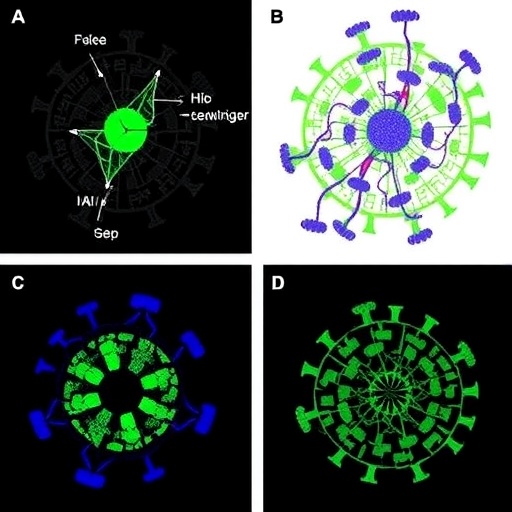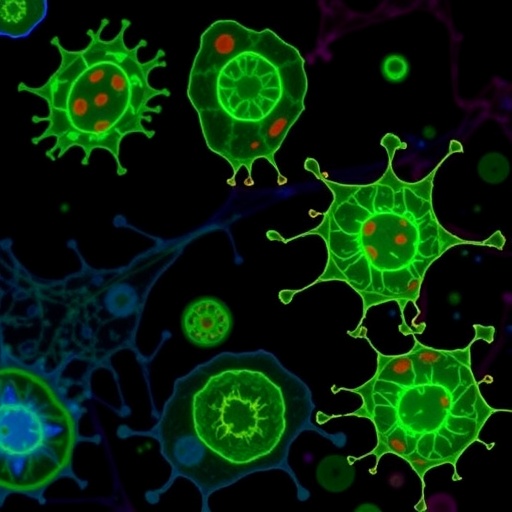In a groundbreaking study published in BMC Cancer, researchers have unveiled the pivotal role of Discoidin Domain Receptor 1 (DDR1) in driving cervical cancer progression and facilitating immune evasion. This comprehensive investigation employed an integrative bioinformatics approach, supported by rigorous experimental validation, to elucidate DDR1’s impact on tumor growth and the complex interplay within the tumor microenvironment. The findings offer promising new avenues for therapeutic intervention against a disease that continues to pose significant challenges to women’s health globally.
Cervical cancer, striking thousands of women each year, often evades immune surveillance through mechanisms that remain incompletely understood. DDR1, a receptor tyrosine kinase known for its role in collagen interaction and cellular signaling, has been implicated in fostering immune escape in various cancers. However, its precise expression patterns and mechanistic involvements in cervical cancer progression have been less clear until this extensive study provided new insights.
By mining data from The Cancer Genome Atlas (TCGA) and utilizing the GEPIA2 analysis platform, the researchers demonstrated a compelling overexpression of DDR1 in cervical cancer tissues compared to normal cervical samples. This upregulation correlated strongly with advanced clinical stages as defined by FIGO classification, as well as with poorer overall survival rates, underscoring DDR1’s prognostic significance.
Delving deeper into the molecular pathways influenced by DDR1, the study implemented gene ontology (GO), Kyoto Encyclopedia of Genes and Genomes (KEGG), and gene set enrichment analysis (GSEA). These revealed that DDR1 modulates critical cellular processes including proliferation, migration, metabolic reprogramming, and immune modulation. This multifaceted influence highlights DDR1 as a linchpin connecting tumor growth with immune escape mechanisms.
Parallel to bioinformatics predictions, experimental validation through immunohistochemistry on clinical tissue samples confirmed high DDR1 protein levels in cervical cancer specimens. This validation was crucial, establishing DDR1 as not only a marker of disease severity but also as an active participant in oncogenic processes throughout the tumor microenvironment.
Further functional assays lent compelling evidence to DDR1’s role in enhancing malignant phenotypes. Western blot analyses revealed that cervical cancer cells overexpressing DDR1 exhibited increased proliferative capacity and migratory potential. Conversely, silencing DDR1 impaired these aggressive features, emphasizing DDR1’s functional importance as a potential molecular target.
Perhaps most strikingly, DDR1 was found to orchestrate immune escape by reshaping the tumor microenvironment. This includes modulation of immune cell infiltration and reprogramming metabolic pathways to create a niche conducive to tumor survival and immune tolerance. Such insights bridge the gap between tumor biology and immune evasion, highlighting DDR1’s dual role in cancer progression and immune suppression.
The immunosuppressive microenvironment induced by DDR1 includes altered metabolic states that impact immune effector cells, thereby reducing their capability to mount an effective anti-tumor response. The study suggests that DDR1 influences both the extracellular matrix and intracellular signaling cascades, facilitating immune evasion which is a major barrier to successful immunotherapy in cervical cancer.
These discoveries carry profound therapeutic implications. Targeting DDR1 could disrupt tumor proliferation and migration directly while simultaneously dismantling the immunosuppressive barriers that protect the tumor from immune attack. This dual-action potential positions DDR1 inhibitors as promising candidates for combinational therapies that integrate with existing immune checkpoint therapies.
The study’s innovative combination of in silico and in vitro approaches sets a precedent for future cancer research paradigms. By leveraging large-scale genomic datasets alongside clinical and molecular experiments, the researchers have charted a comprehensive map of DDR1’s oncogenic landscape in cervical cancer, paving the way for precision medicine strategies.
Furthermore, understanding DDR1’s role in metabolic reprogramming opens new horizons in cancer biology. Targeting metabolic pathways influenced by DDR1 could tailor novel interventions that starve the tumor microenvironment of the conditions necessary for immune escape and tumor resilience.
Given the complex bi-directional crosstalk between cancer cells and the immune system, DDR1’s ability to execute multifaceted roles makes it an especially attractive target. Its blockade could potentially revitalize immune surveillance and restore anti-tumor immunity, which has long been a challenge in advanced cervical cancer management.
The research also raises intriguing questions about DDR1’s interactions with other molecular players within the tumor milieu. Future investigations might explore synergistic therapeutic combinations, as well as DDR1’s role across different histological subtypes and stages of cervical cancer.
Overall, this study heralds a new era in the treatment of cervical cancer, underscoring the importance of targeting not only tumor cells but also the intricate immune landscape shaped by tumor-secreted factors such as DDR1. As the fight against cervical cancer evolves, insights from this research could translate into more effective treatments with improved patient outcomes.
In a field continually searching for breakthroughs against one of the most challenging cancers afflicting women worldwide, the identification of DDR1 as a driver of both cancer progression and immune evasion offers a beacon of hope. The research opens pathways to novel therapeutics aimed at disrupting the cancer’s ability to hide from immune defenses, promising a transformative impact on future clinical practices.
Subject of Research: The role of Discoidin Domain Receptor 1 (DDR1) in cervical cancer progression and immune evasion.
Article Title: DDR1 drives cervical cancer progression and immune evasion: a bioinformatics analysis with experimental verification.
Article References:
Zhou, Y., Guo, X., Han, J. et al. DDR1 drives cervical cancer progression and immune evasion: a bioinformatics analysis with experimental verification. BMC Cancer 25, 1716 (2025). https://doi.org/10.1186/s12885-025-15099-4
Image Credits: Scienmag.com
DOI: 05 November 2025
Tags: bioinformatics in cancer researchcancer genome analysis techniquescervical cancer survival ratescollagen interaction and signalingDDR1 role in cervical cancerFIGO classification and cancer prognosisimmune evasion mechanisms in canceroverexpression of DDR1 in tumorsreceptor tyrosine kinase in oncologytherapeutic interventions for cervical cancertumor microenvironment interactionswomen’s health and cancer





